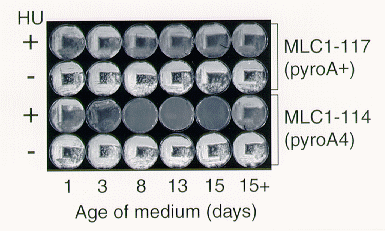
Inactivation of vitamin B6 by hydroxyurea in Aspergillus culture media.
Stan Foster and Peter M. Mirabito - Molecular and Cellular Biology Section, Thomas Hunt Morgan School of Biological Sciences*, and Markey Cancer Center, University of Kentucky, Lexington, KY 40506-0225.
We found that sublethal levels of Hydroxyurea (HU), an inhibitor of ribonucleotide reductase, inhibited the growth of pyroA4 mutants of Aspergillus nidulans. Growth inhibition increased with the age of the HU-containing medium, and was remediated by supplementation with additional vitamin B6, indicating that HU leads to the inactivation of vitamin B6. HU inactivated vitamin B6 in the presence or absence of media components. These results demonstrate a direct affect of HU on vitamin B6, and they complicate the interpretation of results from experiments involving HU and fungal strains auxotrophic for vitamin B6.
Hydroxyurea is a cytotoxic drug used in cell cycle research and in the treatment of sickle cell anemia and certain cancers. Its cytotoxicity in vivo is thought to be due to its action as an inhibitor of ribonucleotide reductase, an enzyme required for synthesis of deoxyribonucleotides (Reichard and Ehrenberg 1983). Cells treated with high levels of HU are unable to replicate DNA and arrest at S phase of the cell cycle (Slater 1973 J Bact 113:263-270.). This S phase arrest is due to the activation of a regulatory pathway that couples cell cycle progression to DNA replication. Genetic screens for HU-sensitive mutants have been used to identify genes in this regulatory pathway (Enoch et al. 1992 Genes Dev 6: 2035-2046).
In the course of screening A. nidulans cell cycle mutants for HU sensitivity, we serendipitously found that a particular batch of YG+HU (0.5% yeast extract, 2% glucose, 10 mM HU) completely inhibited the growth of strains carrying the pyroA4 allele. The inability to germinate on this medium cosegregated with pyroA4 in a cross (n=50) and addition of fresh pyridoxine directly to this medium rescued the growth defect of pyroA4 strains, indicating that the medium was deficient in vitamin B6. To test the hypothesis that HU inactivated vitamin B6 in the medium, we compared the growth of co-isogenic pyroA4 and pyroA+ strains on defined medium (Kafer 1973 Adv Genet 19: 33-131) containing the vitamin B6 compound pyridoxine, with or without 10mM HU. We compared the growth of these strains on medium that was one day old and on medium stored at room temperature for up to 15 days. Figure 1 shows that the growth of the pyroA4 strain MLC1-114 was progressively more inhibited with increasing age of the medium. Germination of MLC1-114 spores was completely inhibited on medium that was 13 days old. In contrast, growth of the pyroA+ strain MLC1-117 was only slightly inhibited on the same medium regardless of its age. The growth of MLC1-114 on 15 day old HU containing medium was restored to control levels by supplementation with additional pyridoxine, confirming that the growth inhibition was due to a lack of vitamin B6. A similar time course of pyridoxine inactivation was found when a mixture of HU and pyridoxine was incubated at room temperature prior to being used
to make culture medium, indicating that the interaction between HU and pyridoxine was direct. Experiments using medium containing pyridoxal as an alternate vitamin B6 supplement yielded similar results.
These results show that HU inactivates vitamin B6 in Aspergillus culture media. Vitamin B6 compounds probably undergo chemical modification by HU, since HU altered the UV absorption spectra and thin layer chromatographic profiles of both pyridoxine and pyridoxal. These observations indicate a need for caution in the use of HU in experiments on cell growth.

Figure 1. Time course of vitamin B6 inactivation by hydroxyurea. Defined medium with or without 10 mM HU was prepared on day zero and stored at room temperature. HU was added to medium after autoclaving. Strains were streaked to single colony on medium with or without HU on days 1, 3, 8, 13, and 15. All cultures were incubated at 37oC for 48 hours. Medium indicated by 15+ was supplemented with additional pyridoxine immediately before use. MLC1-114 (wA2; pyroA4); MLC1-117 (wA2, pabaA1).